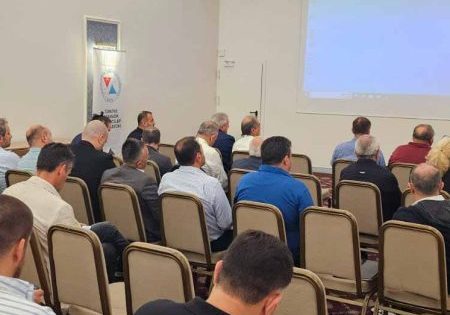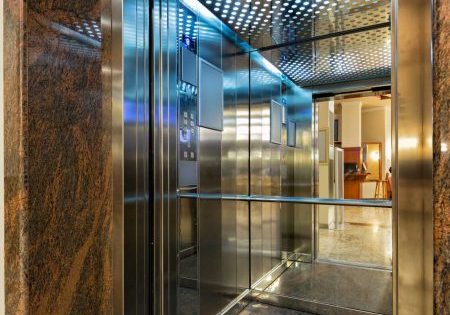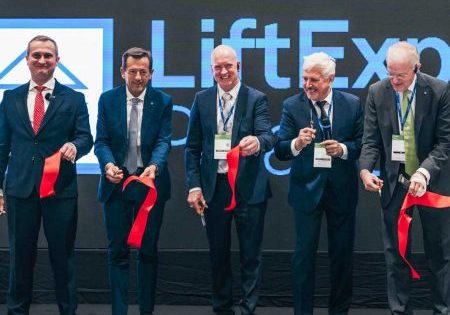A Calculation Proposal For The Lift Car And Counterweight Sling Structure In The Case Of Safety Gear Operation And Seismic Movement
Nov 17, 2024
by Serdar Tavaslıoğlu
Summary
Car and counterweight sling calculation and design have a very important place in lift safety. However, as a habit in many manufacturing companies, the vertical and horizontal beams of the sling are always made with materials of the same thickness and dimensions. No changes are seen in sling sizes and profile thickness even though the lift sizes and rated load change. As a result, in the event of braking or seismic activity, major damage may occur to the slings. Such cases were seen in earthquakes in the past. The importance of working on a calculation method in this regard is obvious. This study provides a suggestion for creating a calculation method by taking into account the safety gear operation of lift slings and the forces given by the standard during a seismic activity.
1. Car Strength Calculations
One of the main parts of lift design is the car that carries people and the counterweight design that balances it. Design and planning for lifts should not be confused. The first ensures that the calculations for manufacturing are done in whole and the relevant Lift and other Directive conditions are met and secured. Planning, on the other hand, shows the placement of such manufacturing in the building, its scaling and connections with the other manufacturing. One refers to calculation and safety while the other refers to scaling and placement. The manufacturing of a car must also have passed a conformity inspection by the manufacturer according to the Essential Safety Requirements, which may be based on self-declaration. Lift companies should request a Declaration of Conformity from the manufacturer for each car they receive. A car manufactured in accordance with the type in the technical file and a declaration of conformity received from the manufacturer saves the lift company from having to make additional calculations. In such a case, the whole responsibility belongs to the car manufacturer. Otherwise, the responsibility will belong to the lift company that issued the Declaration of Conformity for the entire lift. The manufacturer must use a safety gear with a Type Certificate issued by a Notified Body authorized under the Lift Directive for the safety gear used in the car and must state this in the Declaration of Conformity if it is provided with the car. The same applies to lift companies that manufacture the car and counterweight themselves. In the manufacture of a lift that has a car and counterweight Declaration of Conformity in its file, it is assumed that the car calculations, the safety gear used, the declared load and speed are made following the declaration. As the responsibility lies with the car manufacturer, no additional accounting is requested from the lift company. If this declaration is not present, in the event of an accident, the responsibility falls directly on the lift company that issued the Declaration of Conformity stating that the lift was safe. I recommend companies be sensitive about this issue.
Below, a proposed car and counterweight sling calculation has been made based on the TS 1812 December 1988 standard and adapted to today’s calculation method. When making a calculation, it is generally correct to base it on a calculation made and verified by an authority and to adjust it accordingly. This standard is still valid, but the calculation method is not quite compatible with today’s method. Although it has a generally correct approach, it does not include an examination of the forces in the X and Y directions. The recommended calculation method is based on the approach of the TS 1812 Standard and includes the arrangement of forces in the X and Y directions. However, calculations that include more detailed and broad manufacturing types are required to prepare a Type Conformity File. Manufacturing companies must make detailed calculations that include possible diversifications. This file must also contain assembly instructions, a parts list and a user and assembly manual. Preparation of such a detailed file and making it compliant with the Lift and Machinery Directive is important for cars and counterweights, which are one of the main products in the design of lift manufacturing.
2. Stresses in the Car Framework and Flooring
The TS 1812 Standard gives the highest stress values that should be accepted in the calculations. These values are based on the principle that safety margin is determined according to the Jager Approach. Such values are still valid stress values used in beam and column calculations in machine frames, bolt connections, and downhole (inside of the well) partition profiles. TS 1812 standard gives values in kgf. Since Newton is used more in calculations today, an additional N/mm2 column has been added to the table. It is accepted as g = 9.81 m/s2, N ~ 0.1 kgf. For convenience in calculations, the constant of g=9.81 m/s2 is taken as g=10 m/s2. In this case:
1 kgf = 1 kp = 10 N =1 daN
1 kgf/cm2 = 1 bar = 1 kp/ cm2 = 1 at = 10 N/ cm2 = 0,1 N/mm2 = 100 kPa 1 Pa = 1 N/m2
E = 2.1 .106 kgf/cm2 =2.1 .105 N/mm2
| Place of tensIon | Type of tensIon | TensIon (highest) | CalculatIon area | |
| kgf/cm2 | N/mm2 | |||
| Upper beams | Bending | 900 | 90 | Gross section |
| Buffer impact beam | Bending | 1800 | 180 | Gross section |
| Vertical beams | Bending + traction | 1300 | 130 | NET section |
| Beam joints | Bending | 1000 | 100 | Gross section |
| Traction | 1250 | 125 | NET section | |
| Suspension elements fixing elements | Bending + traction | 600 | 60 | NET section |
| Lower beams | Bending | 900 | 90 | Gross section |
| Bolts (1) | Traction | 500 | 50 | NET section |
| Scissoring | 500 | 50 | NET section | |
| Carrier | 1150 | 115 | NET section | |
| Rivets | Bending | 1300 | 130 | Gross section |
| Scissoring | 700 | 70 | NET section | |
| Carrier | 1300 | 130 | ||
| Beams in normal loads | Pressure (2) | 1000-(4,2.L2/R) | 100-(4,2.L2/R) | Gross section |
| 1) If the bolts are subjected to both pressure and tension, the necessary safety checks must be carried out. |
| 2) L = free length of the beam (cm for kgf, mm for N) R = minimum inertia radius of the section (cm for kgf, mm for N) E = 2.1 .106 kgf/cm2 =2.1 .105 N/mm2 |
TS 1812 Article 2.6.6.3 Calculation of vertical beams of the car frame states, “The total stress, slenderness ratio and moment of inertia of each vertical beam in the car framework due to tension and bending are calculated with the following formulas.” The relevant formula and units used are given as follows.
Where;
σTop = Total tension (kPa)
M.L/4.H.Wo = Bending stress of each vertical beam due to the car nominal load (Gy) loaded on the platform
M = Torque (N.m)
L = Free length of the beam between bolted joints (m)
H= Distance between bottom and top guide shoes (m)
W0= Strength moment of vertical beam (m3)
G= Load to be carried by vertical beam due to the nominal load mass of the car on the top floor (kg)
A= Section area (m2)
G/2A=Car declared load on the platform (Gy) and based on this, tensile stress of each vertical beam was taken as kgf/m2 .
If we go over the formula presented by the standard and translate this formula into today’s approach, we can create a foundation. We can examine the formula in two phases as tensile and bending stress. gn.( M.L/(4.H.Wo)), which is the first part of the formula, is given as the bending stress of each vertical beam due to the nominal car load Gy imposed on the platform.
Bending stress
σe = gn. (M.L)/(4.H.W0 )
In passenger lifts, b/8 and in freight lifts carrying distributed loads, b/4 were taken as the moment arm, and Gy=rated load was accepted as the bending force. It was considered that car weight is symmetrical and would not affect the moment arm. ASME, the similar calculation method, was also taken as the same, and the calculation method graphic is shown in Figure 1. However, later standards brought a new approach, and it was accepted that the car weight was also effective here, and that if the car’s center of gravity was off, it would affect the bending moment. Then, instead of Gy as the acting load, if we take Q for the passenger and Pec for the car, and consider b=Dy, it is possible to transform this formula into the formulation we use today. However, what should be noted here is that the weight of the car, excluding the sling, should be taken into consideration in the P value. We can call this Pec. The sign which means “Empty Car” and is used in the seismic calculations would be more appropriate. Then the formula can be written as Fx and Fy as we know it.
Another point to note in Figure 2 is that when calculating Fy in rail calculations, ½ in the n/2 multiplier is not used in the formula because the lower or upper skate acting on a rail press on one side, and the other side remains idle because the Fy force, like Fx, acts on both sides of the car beams. In rail calculations, while Fx acts on two skates, the Fy force acts on the rail with only one skate, and the other skate is on idle. The P value in the formula should be taken as Pec (car weight except sling). In this case, it would be more understandable to use the graph we are accustomed to as a formulation.
If we calculate the moment according to these forces trying to bend, considering that the L beam is fixed at both ends, the L length should be taken from the points where the bolted connections end, and since it is a beam fixed at both sides, it should be formulated as L0 =L/2.
Mx = Fx*L0=Fx*L/2
σx = Mx / Wx =
My = Fy*L0= Fy*L/2
σy =My / Wy
σe = σx +σy
We examine the formula provided by the TS 1812 Standard for unequal load distribution in Fy direction and unilaterally for unequal load distribution in both directions and bilaterally. The bending stress formula given by the standard:
σe = gn. (M.L)/(4.H.W0 )
If we adjust the formula we wrote for n=2 rail accordingly; since L and H are mt in the formula, if we take them as mm and the W value as mm3, the result will be N/mm2.
σe = Mx / Wx = Fx*L/(2*Wx )= gn*(k1.(Q.xq+Pec.xp )).L/(2.2.h.Wx )
= gn*(k1.(Q.xq+Pec.xp )).L/(4.H.Wx )
It will be seen that only the braking coefficient k1 and the empty car weight Pec are added to the calculation of the bending force. The TS 1812 standard also states in article 2.6.6.6, “The maximum force at the moment of braking should also be taken into account in the calculations.” Since we calculate the effect of braking with the k1 multiplier in our new standard acceptance, it complies with the approach of the standard. Thus, the main formula in one direction accepted by the standard is arranged in bending stress in both directions and for both load cases according to today’s mindset. In this way, Fx and Fy forces can be examined for both cases and the bending stress in the vertical beam is calculated if it is assumed that σe = σx +σy is bigger.
The relevant articles of the TS 1812 standard, which were taken as a basis when creating the calculation method, were examined, and the calculations given in one direction were converted to the Fx and Fy forms that we are accustomed to from the two-way and rail calculations and were brought into line with today’s understanding. In this way, if the Fx and Fy values are calculated and substituted for the seismic zone, the calculations of the production can be made within the TS EN 81-77 standard. Thus, with the same calculation method, first the forces in the car can be calculated for the standard lift safety gear operation and checks can be made. Then, the forces during seismic movement can be calculated and checks can be made for normal operation in seismic conditions. For seismic zone force calculations, you can review the article “TS EN 81-77 Lifts – Safety Rules for Construction and Installation – Special Applications for Passenger and Goods Lift – Part 77: Lifts Subject to Seismic Conditions’ Standard Summary and Additional Rail Calculations According to Earthquake Forces – Serdar Tavaslıoğlu’ that I presented at the 2020 Izmir Lift Symposium.
In the TS 1812 Standard, the tensile stress is given in the second part of the formula as follows.
σt = gn
By taking Q+Pec values instead of G and adding the braking impact k1 coefficient,
we can write σt = gn.k1.(Q+Pec ) / 2A.
Here, it will be seen that the braking coefficient and Pec are also added as a difference. The are should be taken as mm2. The total stress will be the sum of bending and tensile stresses.
σT = σe +σt <σEM=130 N/mm2 (Vertical beam safe stress value from Graphic 3)
The standard also requires that the slenderness and moment of inertia of the material be checked. The relevant formula and its conditions are requested in the following articles in relation to these.
2.6.6.3.2 – Slenderness
L/imin < 120
λhe ≤λo=120
λhe =Lbk / imin
imin = (I/A)1/2 formulas are used.
λhe =Degree of slenderness
I = Moment of inertia mm4
imin = Inertia the smallest radius mm
Lbk = Length between consoles mm
A = Section mm2
2.6.6.3.3 – Inertia moment of vertical beams
should be I=(M.L3) / (457,2.E.H) <I0
I = Inertia moment (m4)
E = Flexibility module of the material (kPa)
M = Moment (N.m)
L = Free length of the beam (m)
H = Distance between the bottom and top guide shoes (m).
Instead of using this formula and its units, I think it would be more accurate to check the amount of deflection in steel materials. In steel materials, deflection should be between 1/500 and 1/1000. Safe deflection in horizontal beams is accepted as 1/1000. For vertical beams, the value of 1/750 is a generally accepted ratio. Based on this approach, the deflection amount in vertical beams should not exceed 1/750. If the deflection is calculated using the deflection formula for the rail given in the new standards;
δx = (0.7 . Fx . L3) / (48 . E . Ix) on x-x plane
δy = (0.7 . Fy . L3) / (48 . E . Iy) on y-y plane
δx/L and δy/L ≤ 1/750 ≤δem
I = Moment of inertia (mm4)
L= free length of beams between connections (mm)
imin = minimum radius of inertia of a beam or group of beams (mm)
E = 2.1.105 N/mm2
Rail calculations are made for a continuous beam with one side fixed, while built-in beams are used in the car. Therefore, the multiplier of 0.7 can be used as 0.5, but it cannot be claimed that the horizontal and vertical beams of the car are fully integrated. Thus, it was considered more appropriate and safer to use 0.7 multiplier as is. Another point to be noted here is that in rail calculations, the Fx force in the X direction remains in the Y direction in the rail axis representation, thus affecting the moment of inertia of the rail in the Iy direction. However, since we take the force and inertia directions as the same in this calculation, we need to use the same signed forces and moments of inertia.
In this case, only the calculation of the W and I values of the vertical beam used remains. After this calculation, the strength of the material can be checked. In case of using sheet metal as vertical beam, W and I values can be easily calculated from the formulas in Figure 3.
The connection bolts between the suspension beam and the horizontal beam should be calculated. The braking coefficient must be used in this calculation.
Calculation of shear stress for connection bolts between gussets and beam
τK = gn.k1.(P+Q) /(n.A) < 50 N/mm2 TS 1812 Graphic 3
τK = Shear stress (N/mm2)
n = Number of bolts used
A = Bolt section area (mm2)
2.6.6.3.4- Bending of car framework (Top horizontal suspension beam)
When the car is at the top stop and under the greatest static load, the bending of the upper and lower beams of the car framework should not be greater than 1/1000 of the distance between the supports. The mass of the balance chain or rope, if any, should also be taken into consideration. Since the sling weight is also effective on the upper suspension beams, P should be used directly instead of Pec in this calculation.
F = gn.k1.(P+Q) /2.n
σE =F.(L/2)/Wx
should be σE < σEM= 90 N/mm2 TS 1812 Graphic 3
Deflection in the upper suspension beam of the car framework
δx = 0.7.(F.L3) /(48.E.Ix )
should be δx /L < 1/1000
Wx = Strength moment of the beam (mm3)
δ = The amount of bending in car framework (mm)
F = The force applied by the total load depending on the number of beams (N)
L = Beam’s free length (mm)
E = Elasticity module (N/mm2)
Ix = Inertia moment of the beam
n = Number of beams
2.6.6.5 – Impact stress on the car lower beam
When a single buffer is used under the car, the stresses that will occur in the car impact beam when the car hits the buffer, the load that will occur at both ends of the beam and the buffer hitting the middle of the beam are assumed to be half the sum of the car load and the car and rope masses. So it should be:
σE =gn.k1.L.(P+Q)/(2.n.Wx) < σEM =90 N/mm2
σE = Impact stress on the car lower beam (N/mm2)
gn= Standard gravitational acceleration (9.81 m/s2)
L = Beam’s free length (mm)
P+Q = Total of car and declared load (kg)
n = Number of beams
W = strength moment of car bottom beam (mm3)
2.6.6.7 – Stress calculations of car floor:
During loading or unloading of the car, at the entrance of a car, when the load passes through the door and car threshold, a threshold force Fs acting at the midpoint of the threshold should be taken into account. Since the lift does not move during loading, no motion multiplier is used. In lift cars with different doors, the forces occurring during loading on both doors should be calculated and the ones in the worst-case conditions should be taken. The magnitude of the threshold force should be taken as specified below.
FS = 0,4.gn .Q For lifts with declared load under 2500 kg in buildings such as residence, office, hotel and hospital;
FS = 0,6.gn .Q For lifts with a rated load of 2500 kg or more;
FS = 0,8.gn .Q For lifts with a rated load of 2500 kg or more in the case of loading with a forklift; (TS EN 81-1)
In the bending of the car floor, it is assumed that the loads are applied to the first beam parallel to the car entrance.
F= FS /2
Bending stress
σE = F.(L/2)/Wx
σE < σEM=90 N/mm2. (TS 1812 Graphic 3)
2.2.9. Slenderness:
should be L/imin < 120 Buckling distance in fixed beams L= L0/2
λhe =Lbk / imin
imin = (I/A)1/2
Suspension connection part cutting calculation
Rope connection part cutting or tearing calculations should be made according to the material used.
3. Design of Counterweight Sling
Force at counterweight suspension point
F= gn.k1. (G+K)
It is assumed that the suspension point is centered and the counterweight mass is distributed as shown in Figure 5. Therefore, there is a single load situation in counterweight sling calculations. In counterweight rail calculations, if there is no safety gear on the counterweight, the dynamic factor k2 is used because the car braking has no effect on the rails. However, when calculating the sling, it would be more accurate to use k1 as the dynamic coefficient in the counterweight sling calculations, as the braking in the car will be transmitted to the counterweight in the same way via the ropes.
Counterweight top suspension beam stress should be as follows:
M = (1/2).L1.F/(2.n1)
σE = M /.W
σE < σem =130 N/mm2
Counterweight top suspension beam deflection should be as follows:
δ= 0,7.F.L13/(48.E.I)
%L1 = δ/L1 %L1< 0.001
Counterweight vertical (side suspension) beams tension
Bending stress
The counterweight mass is assumed to be 0.10 off on the X-axis and 0.05 off on the Y-axis.
σx = (Mx / Wx ) Mx= gn.k1.G.(0.10.Dx ).L2 / n2.H
σy = (My / Wy ) My= gn.k1.G.(0.05.Dy ).L2 / n2.H
σe= σx+σy
Tensile stress
σt =gn.G/n.A
Total stress
σT = σt+σe σT < σem =130 N/mm2 olmalıdır.
Degree of slenderness
L/imin <120
n1 : Number of top suspension beams
n2 : Number of side suspension brackets
M : Acting moment
W : Moment of resistance
δ : Deflection occurred
I : Moment of inertia
G : Counterweight mass
K : Counterweight sling weight
L1 : Üst askı kirişi boyu
L2 : Length of side suspension bracket
k1 : Dynamic impact factor depending on the type of safety gear used
k2 :1.2 Dynamic impact coefficient due to sudden electromechanical braking effect
d : Depth of counterweight
b : Counterweight width
H : Distance between counterweight skates
E : Elasticity module
(Units are used as mm, kg, N, and N/mm2)
4. Forces Acting on Rails in Case of Seismic Event
In case of seismic conditions, the TS EN 81/77 standard defines the forces acting on the rails. When examining this condition, since there is no braking, the normal usage factor k2 should be used as the dynamic factor. While the PEC expression was used in the first version of the standard, this value was taken as P in the later version, but since we want to calculate the force acting on the carcass, we will still use the Pec value in the formula. The QSE value was used as the rated load acting on the car at the time of the earthquake. XSE value is also defined within the effect of this value. For the calculation of these values and ad value, the article “TS EN 81-77 Lifts – Safety Rules for Construction and Installation – Special Applications for Passenger and Goods Lift – Part 77: Lifts Subject to Seismic Conditions” Standard Summary and Additional Rail Calculations According to Earthquake Forces – Serdar Tavaslıoğlu” presented at the 2020 Izmir Lift Symposium can be reviewed. Formulas for the rail calculation given by the standard TS EN 81/77 are stated below.
a) Bending stress in relation to the Y-axis of the guide rail caused by the guide forces:
FX= k2.gn.[QSE*(xQ-xS )+ PEC.(xP-xS )] / n.h +(ax.( PEC+ QSE ).XSE)/n
MY= (3.FX .LK ) / 16 , σy = My / Wy
b) Bending stress in relation to the X-axis of the guide rail caused by the guide forces:
FY= k2.gn.[QSE.(yQ-yS )+ PEC.(yP-yS )] / (h.n/2) +(ay.( PEC+ QSE ).XSE)/(n/2)
MX= (3. FY. LK ) / 16 , σx= Mx / Wx
Total Bending Stress
σ =σm= σx + σy ≤σperm
QSE = kSE*Q
The seismic force that would be generated by the earthquake design acceleration is specified by the standard as follows
FSE = ad (PEC + kSE.Q) For car,
FSE = ad (PEC + q.Q) For counterweight and counterbalance weight,
QSE Mass of rated load to be considered under seismic conditions kg
kse Seismic load factor (0.4 for passenger lifts and 0.8 for goods lifts)
Q Rated load kg
FSE Additional force resulting from seismic design acceleration N
ad Seismic design acceleration m/s2
PEC Mass of empty car without taking into account control cable and balance chains kg
q Counterweight or balancing weight balance ratio value
Counterweight or balancing weight calculations
Bending stress
Center of gravity misalignment should always be considered on the opposite side for negative conditions. Since we are making the sling calculation, we can assume that the car and counterweight slings are close to each other. Then, it may also be more accurate to use PEC value instead of P value.
FX = [k2.gn.(PEC+ q.Q).ex.Dx ] / n.h +(ax.( PEC+q*Q).XSE )/n
MY= 3.FX.L /16 , σY = MY / WY
FY = (k2.gn.(PEC+ q.Q).ey.Dy ) 2 / n.h +(ay.( PEC+q. Q).XSE )/(n/2)
MX= 3.FY.L /16 , σX = MX / WX
5. Arrangement of Forces Acting on the Rail for the Car Sling
If this formulation made for the rail is adjusted for sling calculations as it was done before for the safety gear work, it can be written as follows.
FX= k2.gn.[QSE.(xQ-xS )+ PEC.(xP-x S)] / n.h +(ax.( PEC+ QSE ).XSE )/n
Mx = Fx.L0=Fx.L/2
σx = Mx / Wx
FY= k2.gn.[QSE.(yQ-yS )+ Pec.(yP-yS )] / (h.n) +(ay.( Pec+ QSE ).XSE )/(n)
My = Fy.L0= Fy.L/2
σy =My / Wy
σe = σx +σy
The Pec value should be taken as the empty car weight excluding the sling in car beam calculations without taking into account the control cable and balance chains. Tensile stress calculations for car beams must also be made. P value should be used as the sling weight will also have an impact on this calculation.
σt = gn.k2.(Q+P) /A
Here, it will be seen that the braking coefficient and P are also added as a difference. The area A should be taken as the area of beams (in mm2). Total stress should be:
σT =σe+σç < 130 N/mm2
If the same adjustment is made for the counterweight sling calculations;
FX = (k2.gn.(PEC+ q.Q).ex.Dx ) / n.h +(ax.( PEC+q.Q).XSE )/n
Mx = Fx*L0=Fx*L/2
σx = Mx / Wx
FY = (k2.gn.(PEC+ q*Q).ey.Dy )/ (n.h) +(ay.( PEC+q* Q).XSE )/(n)
My = Fy.L0= Fy.L/2
σy =My / Wy
σe = σx +σy
The tensile stress should also be calculated.
σt = gn.k2.(q.Q+P)/A
Total stress
should be σT =σe+σt < 130 N/mm2 (Safe stress value of vertical beam from Graphic 3)
According to these new forces, slenderness and vertical beam deflections should be calculated for a seismic condition in the car and counterweight.
Slenderness:
L/imin < 120
λhe ≤ λo=120
λhe =Lbk / imin
imin = (I/A)1/2 formulas are used.
λhe =Degree of slenderness
I = Moment of inertia mm4
imin = Inertia the smallest radius mm
Lbk = Length between consoles mm
A = Section mm2
Deflection
δx = (0.7 . Fx . L3) / (48 . E . Ix ) on x-x plane
δy = (0.7 . Fy . L3) / (48 . E . Iy ) on y-y plane
δx/L and δy /L ≤ 1/750 ≤ δem
I = Moment of inertia (mm4)
L= free length of beams between connections (mm)
imin = minimum radius of inertia of a beam or group of beams (mm)
E = 2.1.105 N/mm2
6. Evaluation of BRACKETS Calculations in Case of a Seismic Event
In the paper “Stresses Occurring in Brackets and Connection Parts in Lifts – Özgür Mert, İlhan Yeter, Serdar Tavaslıoğlu” presented at the Izmir Lift Symposium, the calculations of brackets and partitions were mentioned. The critical situation was that if the safety gear was held unilaterally, the Fy force could cause damage to the brackets. Fx force, on the other hand, did not cause a force. Formulation on this is given in Figure 7.
However, Fx and Fy forces occur quite high in a seismic event. Bracket calculations should be reviewed for seismic zone. The force formulas Fx and Fy used for the rails before making arrangements for the car should be used. Fx should also be included in the bending calculation. In Figure 8,
it should be evaluated as σbending= σx+ σy
While examining this situation, the Fx force, which is quite high, should be examined for the brackets dowels, and it should be examined whether the dowels have sufficient tensile strength against this force. Fx force will try to remove the dowels according to the K point, as shown in the Figure 9.
Fc2 /Fc1=((a-d)/2)/((d+(a-d)/2)=f
f = ((a-d)/2)/(d+(a-d)/2) =
A F value can be found according to values a and d: in this case, equality can be reached more easily.
Fc2=Fc1.f
Fx*(h+c)=Fc1.(d +(a-d)/2)+Fc2.(a-d)/2.
Fc1=( Fx.(h+c)/((d +((a-d)/2).(1+f))
In seismic conditions, dowels and brackets that come loose from the walls pose a great danger. Therefore, it is important to use certified dowels with known tensile values. It is recommended to use seismic dowels in seismic conditions.
7. Conclusion
Car and counterweight sling calculations, which are one of the important parts of lift design, are an important part of lift safety. With the developing technical structure, it is possible to make much more precise calculations with the help of computers. Processing sheet metal is certainly a work of craftsmanship, but beforehand, calculations must be made, and the materials must be determined in a way that will provide adequate safety. This study is a suggested study to help with the forces that need to be taken into consideration. Each unit that carries out these productions should work with more sensitive and reliable computer programs and make sure that the manufacturing are safe. These manufacturings should not be regarded as a simple sheet metal bending and cutting process. More attention should be paid to the exterior design of the car than its interior design. It would not be correct to perform any operations on the basis of this article and the author declares in advance that he will not be held responsible in this regard. I hope the suggested calculation will be useful and help you in calculating the cross-sections and thicknesses of the manufacturing.
References
1. TS EN 81-20 Asansörler – Yapım Ve Montaj İçin Güvenlik Kuralları – İnsan Ve Yük Taşıma Amaçlı Asansörler – Bölüm 20: İnsan Ve Yük Asansörleri, Ekim 2014
2. TS EN 81-50 Asansörlerin yapımı ve kurulumu için güvenlik kuralları – İnceleme Ve Deneyler – Bölüm 50: Asansör Bileşenlerinin Tasarım Kuralları, Hesaplamaları, İncelemeleri Ve Deneyleri, Ekim 2014
3. “TS EN 81-77 Asansörler – Yapım Ve Montaj İçin Güvenlik Kuralları – Yolcu ve Yük Asansörleri İçin Özel Uygulamalar – Bölüm 77: Sismik Durumlara Tabi Asansörler”
4. TS 1812 Asansörlerin Hesap, Tasarım Ve Yapım Kuralları Aralık 1988
5. Mukavemet Değerleri, Kasım 2009 M. GÜVEN KUTAY
6. Asansör Uygulamaları, Kasım 2005 SERDAR TAVASLIOĞLU
7. İzmir Asansör Sempozyumu “TS EN 81-77– Bölüm 77: Sismik Durumlara Tabi Asansörler” Standart Özeti Ve Deprem Kuvvetlerine Göre İlave Ray Hesapları-Serdar Tavaslıoğlu”
8. İzmir Asansör Sempozyumu “Asansörde Konsol Ve Bağlantı Parçalarında Oluşan Gerilmeler – Özgür Mert, İlhan Yeter, Serdar Tavaslıoğlu”
Get more of Elevator World. Sign up for our free e-newsletter.









